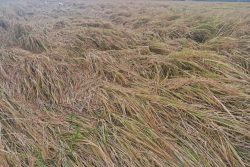Despite having the official label of being a food secure nation, it is no secret that Guyana is anything but. Large pockets of our population struggle with access to food and are undernourished. Poverty stands as one of the main contributing factors towards food accessibility, but other things such as geography and the ever-increasing threat of climate change also have a significant role to play. This has become even more pronounced given the health, environmental and social circumstances that we are currently experiencing.
With coastal portions of Guyana lying approximately one meter below sea level at high tide, our nation has largely become expectant, if not accustomed, to flooding. While during May-June periods these floods come and go with little fanfare, this year has seen significant changes. This has caused many to reflect on the details and trauma that was inflicted by the 2005 “Great Flood,” that particularly affected Region 4 and its environs. The flooding that began in 2004 and really came to a head in ‘05 saw large-scale food insecurity, losses and damage that many took quite a long time to recover from. With a total of thirty-four lives lost, both through drowning and illnesses caused by the floodwaters, that period is a constant reminder of how vulnerable Guyanese along the Coast are.
While we have yet to experience flooding on that scale again, the changing weather patterns can very well lead us into a future where that is our constant reality. During this year, the uncharacteristic rainfall has also demonstrated the vulnerability of those within rural and Indigenous communities. Entire communities lay submerged under water for days following the disastrous Tropical Wave that particularly impacted Regions six, three, nine, four and one.
With many of these Regions being agrarian oriented ones, the impacts of the flood were felt not only by crop and livestock farmers, whose losses were astronomical, but also by consumers across the length and breadth of Guyana. The losses experienced by farmers contributed towards severe shortages in many goods that caused prices to soar rapidly. This happened against the backdrop of already increased food costs brought about due to decreased import rates during the beginning stages of the COVID-19 pandemic. While imports have once again increased, prices remain consistent with the period of shortage, whereas unemployment and underemployment rates continue to climb.
The government has begun an initiative focused on compensating farmers for their losses, but they will need to begin seriously thinking of the long- term effects of climatic changes and the necessary mitigation strategies that are needed. These changing weather patterns do not happen in a vacuum, but rather are the cumulative result of global warming propelled by developed countries, and Guyana’s increased focus on the extractive industries – particularly as it relates to logging, gold and oil extraction. There continues to be the illusion that Guyana can carefully balance the pursuit of a green economy and the growth of extractive industries, but what we are seeing is merely the beginning of an economy that will always prioritize extraction over green and communal security.
This gives us a snapshot of a Guyana in which there are two existences. The one that will be heavily promoted is Guyana’s new standing as a middle-income country, where wealth is present and apparent. Persons falling within this category will largely remain unaffected by the increased costs of living. Those who are classed, as the working poor, the nine to fivers and the middle class however, will feel increased struggles of survival in a country whose growth continues to leave them behind. Already, persons are struggling to meet their basic needs and are skipping meals in order to make ends meet. Many lack access to safe and nutritious food and the situation will not be readily improved if significant changes are not made. It sounds grim, but if the current trajectory continues, it is only a matter of time before Guyana loses its badge (however mythic) of food security in the face of rising costs and increased natural disasters.









